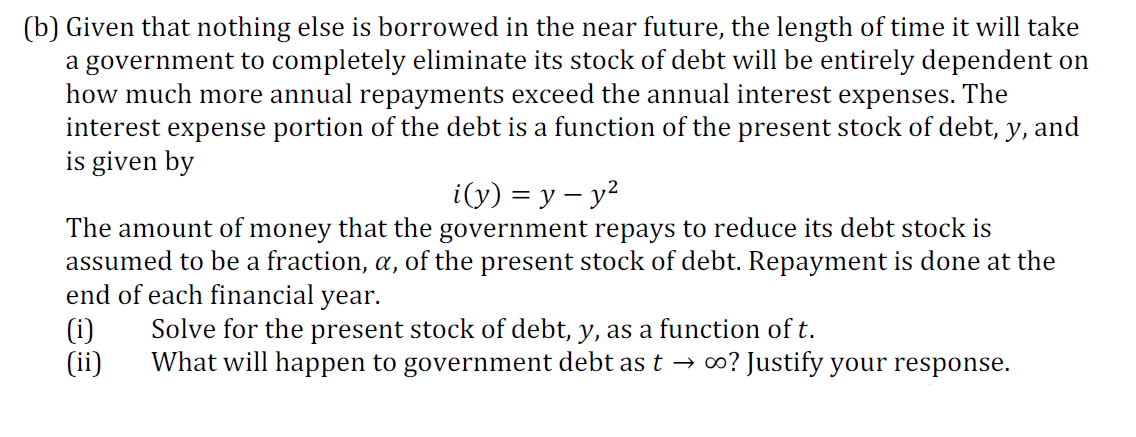(b) Given that nothing else is borrowed in the near future, the length of time it will take a government to completely eliminate its stock of debt will be entirely dependent on how much more annual repayments exceed the annual interest expenses. The interest expense portion of the debt is a function of the present stock of debt, y, and is given by i(y) = y - y² The amount of money that the government repays to reduce its debt stock is assumed to be a fraction, a, of the present stock of debt. Repayment is done at the end of each financial year. (i) (ii) Solve for the present stock of debt, y, as a function of t. What will happen to government debt as t→ ∞o? Justify your response.
(b) Given that nothing else is borrowed in the near future, the length of time it will take a government to completely eliminate its stock of debt will be entirely dependent on how much more annual repayments exceed the annual interest expenses. The interest expense portion of the debt is a function of the present stock of debt, y, and is given by i(y) = y - y² The amount of money that the government repays to reduce its debt stock is assumed to be a fraction, a, of the present stock of debt. Repayment is done at the end of each financial year. (i) (ii) Solve for the present stock of debt, y, as a function of t. What will happen to government debt as t→ ∞o? Justify your response.
Chapter1: Making Economics Decisions
Section: Chapter Questions
Problem 1QTC
Related questions
Question

Transcribed Image Text:(b) Given that nothing else is borrowed in the near future, the length of time it will take
a government to completely eliminate its stock of debt will be entirely dependent on
how much more annual repayments exceed the annual interest expenses. The
interest expense portion of the debt is a function of the present stock of debt, y, and
is given by
i(y) %3D у — у?
The amount of money that the government repays to reduce its debt stock is
assumed to be a fraction, a, of the present stock of debt. Repayment is done at the
end of each financial year.
(i)
(ii)
Solve for the present stock of debt, y, as a function of t.
What will happen to government debt as t → ∞? Justify your response.
Expert Solution
This question has been solved!
Explore an expertly crafted, step-by-step solution for a thorough understanding of key concepts.
Step by step
Solved in 4 steps

Recommended textbooks for you


Principles of Economics (12th Edition)
Economics
ISBN:
9780134078779
Author:
Karl E. Case, Ray C. Fair, Sharon E. Oster
Publisher:
PEARSON

Engineering Economy (17th Edition)
Economics
ISBN:
9780134870069
Author:
William G. Sullivan, Elin M. Wicks, C. Patrick Koelling
Publisher:
PEARSON


Principles of Economics (12th Edition)
Economics
ISBN:
9780134078779
Author:
Karl E. Case, Ray C. Fair, Sharon E. Oster
Publisher:
PEARSON

Engineering Economy (17th Edition)
Economics
ISBN:
9780134870069
Author:
William G. Sullivan, Elin M. Wicks, C. Patrick Koelling
Publisher:
PEARSON

Principles of Economics (MindTap Course List)
Economics
ISBN:
9781305585126
Author:
N. Gregory Mankiw
Publisher:
Cengage Learning

Managerial Economics: A Problem Solving Approach
Economics
ISBN:
9781337106665
Author:
Luke M. Froeb, Brian T. McCann, Michael R. Ward, Mike Shor
Publisher:
Cengage Learning

Managerial Economics & Business Strategy (Mcgraw-…
Economics
ISBN:
9781259290619
Author:
Michael Baye, Jeff Prince
Publisher:
McGraw-Hill Education